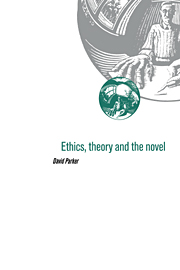Book contents
- Frontmatter
- Contents
- Acknowledgements
- Part I THE ETHICAL UNCONSCIOUS
- Part II SOCIAL BEINGS AND INNOCENTS
- Chapter 6 ‘Bound in Charity’: Middlemarch
- Chapter 7 Forgetting and disorientation in Anna Karenina
- Chapter 8 Two ideas of innocence in The white peacock
- Chapter 9 Into the ideological unknown: Women in love
- Chapter 10 Lawrence and Lady Chatterley: the teller and the tale
- Part III TOWARDS A NEW EVALUATIVE DISCOURSE
- Notes
- Bibliography
- Index
Chapter 8 - Two ideas of innocence in The white peacock
Published online by Cambridge University Press: 05 November 2011
- Frontmatter
- Contents
- Acknowledgements
- Part I THE ETHICAL UNCONSCIOUS
- Part II SOCIAL BEINGS AND INNOCENTS
- Chapter 6 ‘Bound in Charity’: Middlemarch
- Chapter 7 Forgetting and disorientation in Anna Karenina
- Chapter 8 Two ideas of innocence in The white peacock
- Chapter 9 Into the ideological unknown: Women in love
- Chapter 10 Lawrence and Lady Chatterley: the teller and the tale
- Part III TOWARDS A NEW EVALUATIVE DISCOURSE
- Notes
- Bibliography
- Index
Summary
In his first book Lawrence dramatises his own discovery of artistic and ethical identity – in some ‘strong evaluations’ which are at once post-Romantic, sub-Nietzschean and idiosyncratically Lawrentian. The remarkable thing in this very early book is that you can see Lawrence's own conscious ‘metaphysic’, along with its characteristic distinctions of human worth, already in place. Significantly, The White Peacock centres on the vision of a Fall from rural ‘innocence’ into post-industrial ‘social being’, conceived very much in the terms he would use almost twenty years later in the Galsworthy essay. He is much preoccupied with childish narcissism, dependence, and cowardice, for instance, especially in the face of sexual challenge, and these are constantly being explained, indeed over-explained, in terms of a framework of ideas about the supposedly disabling nature of civilised consciousness. Right from the start, Lawrence's own work exhibits the dangers of a conscious ‘metaphysic’ in a novel, and many of his own problems (as well as many of his achievements), even here, spring from the sheer expressive power of his explicit vision of nature and modern civilisation as opposed values.
At the same time The White Peacock encompasses much that is at odds with its stated themes – and with the accounts of the matising critics. The Romantic part-truth that the novel insists on, that there is a healthy animal instinctiveness which is in ‘innocent’ connection with the natural world, is ever in tension with more complex apprehensions realised in the human drama it sets before us.
- Type
- Chapter
- Information
- Ethics, Theory and the Novel , pp. 126 - 144Publisher: Cambridge University PressPrint publication year: 1994



